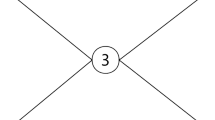Abstract
In this paper, we consider the status of economics as a science, especially as compared to the most successful of sciences, physics, and formulate this in terms of the Popperian notion of criticisability (an extension of his earlier falsifiability demarcation criterion between science and other studies). We then discuss how methods having some similarity to models prevalent in physics might help elucidate dynamic analyses of heuristic learning in economics, though each of the two felds has a unique conceptual framework.
Similar content being viewed by others
References
V. Bala, S. Goyal, Learning from Neighbours, Rev. Econ. Stud. 65, 595 (1998)
A. Bandyopadhyay, R. Roy, A. Sarkar, On the one-dimensional learning from neighbours model”, Electron. J. Probab. 15, 1574 (2010)
S.C. Bhargava, A. Kumar, A. Mukherjee, A Stochastic Cellular Automata Model of Innovation Diffusion, Technological Forecasting and Social Change 44, 87 (1993)
K. Chatterjee, B. Dutta, Credibility and strategic learning on networks, forthcoming in the Int. Econ. Rev. (2016)
K. Chatterjee, S. Hong Xu, Technology Diffusion by Learning from Neighbours, Adv. Appl. Probab. 36, 355 (2004)
J.S. Coleman, E. Katz, H. Menzel, Medical Innovation: A Diffusion Study (Bobbs-Merrill, Indianopolis, Indiana, 1966)
T.G. Conley, C. Udry, Learning About a New Technology: Pineapple in Ghana, Am. Econ. Rev. 100, 35 (2010)
M. Draief, M. Laurent, Epidemics and Rumours in Complex Networks, London Mathematical Society Lecture Notes no. 369 (Cambridge University Press, Cambridge, UK, 2010)
R.T. Durrett, Random Graph Dynamics (Cambridge University Press, New York and Cambridge, 2007)
G. Ellison, Learning, Local Interaction and Coordination, Econometrica 71, 1047 (1993)
G. Ellison, F. Drew, Rules of Thumb for Social Learning, J. Political Econ. 101, 612 (1993)
G. Ellison, F. Drew, Word-of-mouth Communication and Social Learning, Q. J. Econ. 109, 93 (1995)
A.D. Foster, M. Rosenzweig, Learning by Doing and Learning from Others: Human Capital and Technological Change in Agriculture, J. Political Econ. 103, 1176 (1995)
A. Galeotti, S. Goyal, Influencing the Influencers: a Theory of Strategic Diffusion, RAND J. Econ. 40, 509 (2009)
S. Goyal, Learning in Networks, in G. Demange and M. Wooders (eds.), Group Formation in Economics (Cambridge University Press, Cambridge, 2005)
S. Goyal, A. Vigier, Robust Networks, mimeo (University of Cambridge, Faculty of Economics, 2010)
The Guardian newspaper, India farmers think big but grow micro to enrich their soil, March 13, 2013
M. Jackson, Social and Economic Networks (Princeton University Press, Princeton, New Jersey, USA, 2008)
D. Kempe, J. Kleinberg, E. Tardos, Maximizing the Spread of Influence in a Social Network, Proceeding of the Ninth ACM SIGKDD International Conference on Knowledge Discovery and Data Mining, 2003
A. Mehta, J.M. Luck, Models of Competitive Learning: Complex Dynamics, Intermittent Conversions and Oscillatory Coarsening, mimeo S.N. Bose Centre for Basic Sciences and Service de Physique Théorique, CEA Saclay, 2000
K. Munshi, Social Learning in a Heterogeneous Population: Technology Diffusion in the Indian Green Revolution, J. Dev. Econ. 73, 185 (2004)
K.R. Popper, Logic of Scientific Discovery (Routledge, London and New York, 1959) http://strangebeautiful.com/other-texts/popper-logic-scientific-discovery.pdf
K.R. Popper, Conjectures and Refutations; the Growth of Scientific Knowledge” (Basic Books, London, New York, (1962) http://www.rosenfels.org/Popper.pdf
M. Richardson, P. Domingos, Mining Knowledge-Sharing and Sites for Viral Marketing, Proceeding of the Eighth ACM SIGKDD International Conference on Knowledge Discovery and Data Mining, 2002
H.P. Young, Innovation Diffusion in Heterogeneous Populations; Contagion, Social Influence and Social Learning, Am. Econ. Rev. 99, 1899 (2009)
Author information
Authors and Affiliations
Corresponding authors
Rights and permissions
About this article
Cite this article
Chatterjee, K., Roy, S. Two models of social learning in networks, with concepts drawn from economics and physics. Eur. Phys. J. Spec. Top. 225, 3151–3157 (2016). https://doi.org/10.1140/epjst/e2016-60205-9
Received:
Revised:
Published:
Issue Date:
DOI: https://doi.org/10.1140/epjst/e2016-60205-9




